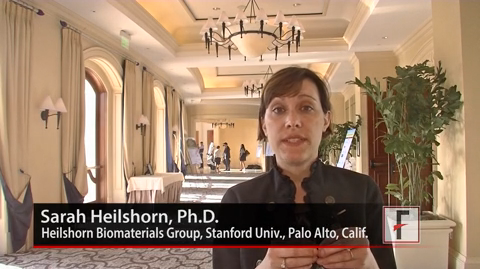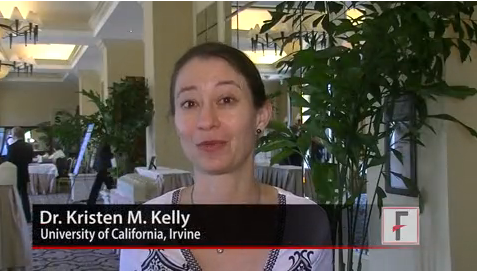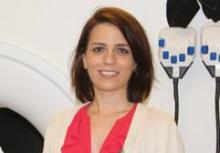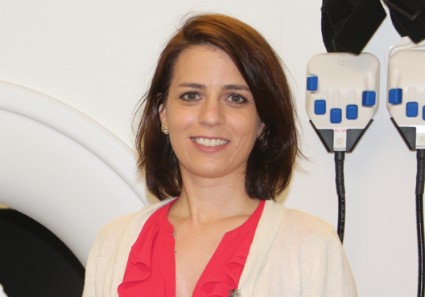User login
VIDEO: Stress and inflammatory skin diseases – Does the science prove a link?
CHICAGO – The data are still being developed, but evidence of a direct link between stress and inflammatory skin conditions continues to mount.
The research is especially compelling for psoriasis; experimental data suggest that stress triggers the nerves to release elevated levels of neuropeptides and neurotransmitters, which in turn affect the nervous system.
Dr. Richard Granstein, chairman of the dermatology department at Weill Cornell Medical College in New York, gave an exclusive interview to Frontline Medical News in which he described studies of how calming the nerves clearly interrupts psoriatic and other inflammatory skin conditions. Dr. Granstein discussed the implications of this new, and still controversial, line of research, and what this means for clinicians: Should they prescribe stress management programs to their patients with these skin conditions?
Dr. Granstein disclosed he has financial relationships with Velius and Clinique.
The video associated with this article is no longer available on this site. Please view all of our videos on the MDedge YouTube channel
On Twitter @whitneymcknight
CHICAGO – The data are still being developed, but evidence of a direct link between stress and inflammatory skin conditions continues to mount.
The research is especially compelling for psoriasis; experimental data suggest that stress triggers the nerves to release elevated levels of neuropeptides and neurotransmitters, which in turn affect the nervous system.
Dr. Richard Granstein, chairman of the dermatology department at Weill Cornell Medical College in New York, gave an exclusive interview to Frontline Medical News in which he described studies of how calming the nerves clearly interrupts psoriatic and other inflammatory skin conditions. Dr. Granstein discussed the implications of this new, and still controversial, line of research, and what this means for clinicians: Should they prescribe stress management programs to their patients with these skin conditions?
Dr. Granstein disclosed he has financial relationships with Velius and Clinique.
The video associated with this article is no longer available on this site. Please view all of our videos on the MDedge YouTube channel
On Twitter @whitneymcknight
CHICAGO – The data are still being developed, but evidence of a direct link between stress and inflammatory skin conditions continues to mount.
The research is especially compelling for psoriasis; experimental data suggest that stress triggers the nerves to release elevated levels of neuropeptides and neurotransmitters, which in turn affect the nervous system.
Dr. Richard Granstein, chairman of the dermatology department at Weill Cornell Medical College in New York, gave an exclusive interview to Frontline Medical News in which he described studies of how calming the nerves clearly interrupts psoriatic and other inflammatory skin conditions. Dr. Granstein discussed the implications of this new, and still controversial, line of research, and what this means for clinicians: Should they prescribe stress management programs to their patients with these skin conditions?
Dr. Granstein disclosed he has financial relationships with Velius and Clinique.
The video associated with this article is no longer available on this site. Please view all of our videos on the MDedge YouTube channel
On Twitter @whitneymcknight
EXPERT ANALYSIS FROM THE AAD SUMMER ACADEMY 2014
AUDIO: Unusual approaches to unusual tumors
CHICAGO – Doctors who don’t abide by accepted norms can sometimes achieve better outcomes when treating patients who have unusual and tenacious tumors. This was the theme of a session covering cases of confounding tumors at the American Academy of Dermatology summer meeting.
In an interview after the session, panel moderator and case presenter Dr. John A. Carucci, chief of Mohs and dermatologic surgery at New York (N.Y.) University, shared his thoughts on when certain kinds of imaging are more appropriate than others, even if it’s not the "usual way."
Dr. Carucci also addressed the use of postsurgical negative pressure wound therapy, radiation therapy in conjunction with Mohs surgery, and potentially controversial topics such as the use of a protein kinase inhibitor as a neoadjuvant therapy.
And what new information on staging squamous cell carcinomas has Dr. Carucci and his colleagues excited? Listen and find out. Dr. Carucci said that he had no financial conflicts to disclose.
On Twitter @whitneymcknight
CHICAGO – Doctors who don’t abide by accepted norms can sometimes achieve better outcomes when treating patients who have unusual and tenacious tumors. This was the theme of a session covering cases of confounding tumors at the American Academy of Dermatology summer meeting.
In an interview after the session, panel moderator and case presenter Dr. John A. Carucci, chief of Mohs and dermatologic surgery at New York (N.Y.) University, shared his thoughts on when certain kinds of imaging are more appropriate than others, even if it’s not the "usual way."
Dr. Carucci also addressed the use of postsurgical negative pressure wound therapy, radiation therapy in conjunction with Mohs surgery, and potentially controversial topics such as the use of a protein kinase inhibitor as a neoadjuvant therapy.
And what new information on staging squamous cell carcinomas has Dr. Carucci and his colleagues excited? Listen and find out. Dr. Carucci said that he had no financial conflicts to disclose.
On Twitter @whitneymcknight
CHICAGO – Doctors who don’t abide by accepted norms can sometimes achieve better outcomes when treating patients who have unusual and tenacious tumors. This was the theme of a session covering cases of confounding tumors at the American Academy of Dermatology summer meeting.
In an interview after the session, panel moderator and case presenter Dr. John A. Carucci, chief of Mohs and dermatologic surgery at New York (N.Y.) University, shared his thoughts on when certain kinds of imaging are more appropriate than others, even if it’s not the "usual way."
Dr. Carucci also addressed the use of postsurgical negative pressure wound therapy, radiation therapy in conjunction with Mohs surgery, and potentially controversial topics such as the use of a protein kinase inhibitor as a neoadjuvant therapy.
And what new information on staging squamous cell carcinomas has Dr. Carucci and his colleagues excited? Listen and find out. Dr. Carucci said that he had no financial conflicts to disclose.
On Twitter @whitneymcknight
EXPERT ANALYSIS FROM THE AAD SUMMER ACADEMY 2014
AUDIO: An interview with Dr. Thomas Insel – Part I
HOLLYWOOD, FLA. – Imagine if you’d gone to medical school with the intention of becoming a psychiatrist, only to be told that part of your core curriculum would include a course on biomaterials engineering or nanoscience.
If all goes according to the current plan of President Barack Obama’s BRAIN Initiative (Brain Research through Advancing Innovative Neurotechnologies), announced in April 2013, these disciplines, and many other so-called nontraditional medical sciences, will be foundational to understanding the human mind and brain.
It’s a development welcomed by the director of the National Institute of Mental Health, Dr. Thomas Insel, who says that neuropsychiatry lacks the necessary tools to identify, treat, and prevent mental and neurologic illnesses.
We spoke with Dr. Insel after the plenary session of this year’s American Society of Clinical Psychopharmacology annual meeting, formerly known as the New Clinical Drug Evaluation Unit meeting. We discussed how the BRAIN Initiative could change practice for psychiatrists and other mental health professionals. This is part I of that conversation.
On Twitter @whitneymcknight
HOLLYWOOD, FLA. – Imagine if you’d gone to medical school with the intention of becoming a psychiatrist, only to be told that part of your core curriculum would include a course on biomaterials engineering or nanoscience.
If all goes according to the current plan of President Barack Obama’s BRAIN Initiative (Brain Research through Advancing Innovative Neurotechnologies), announced in April 2013, these disciplines, and many other so-called nontraditional medical sciences, will be foundational to understanding the human mind and brain.
It’s a development welcomed by the director of the National Institute of Mental Health, Dr. Thomas Insel, who says that neuropsychiatry lacks the necessary tools to identify, treat, and prevent mental and neurologic illnesses.
We spoke with Dr. Insel after the plenary session of this year’s American Society of Clinical Psychopharmacology annual meeting, formerly known as the New Clinical Drug Evaluation Unit meeting. We discussed how the BRAIN Initiative could change practice for psychiatrists and other mental health professionals. This is part I of that conversation.
On Twitter @whitneymcknight
HOLLYWOOD, FLA. – Imagine if you’d gone to medical school with the intention of becoming a psychiatrist, only to be told that part of your core curriculum would include a course on biomaterials engineering or nanoscience.
If all goes according to the current plan of President Barack Obama’s BRAIN Initiative (Brain Research through Advancing Innovative Neurotechnologies), announced in April 2013, these disciplines, and many other so-called nontraditional medical sciences, will be foundational to understanding the human mind and brain.
It’s a development welcomed by the director of the National Institute of Mental Health, Dr. Thomas Insel, who says that neuropsychiatry lacks the necessary tools to identify, treat, and prevent mental and neurologic illnesses.
We spoke with Dr. Insel after the plenary session of this year’s American Society of Clinical Psychopharmacology annual meeting, formerly known as the New Clinical Drug Evaluation Unit meeting. We discussed how the BRAIN Initiative could change practice for psychiatrists and other mental health professionals. This is part I of that conversation.
On Twitter @whitneymcknight
VIDEO: Biogels boost targeted delivery of growth factor in severe wounds
DANA POINT, CALIF.– Materials science meets medicine. That’s the new frontier for many specialties, thanks to advances in the understanding of native tissue dynamics and how bioengineered materials will perform in vivo.
Sarah Heilshorn, Ph.D., of the department of materials science and engineering and the department of bioengineering at Stanford (Calif.) University, was one of several presenters at this year’s Summit in Aesthetic Medicine, with a focus on the use of synthetic materials for reconstructive surgery and treatment for acute and traumatic tissue injury.
In this video, Dr. Heilshorn explains how materials science and bioengineering are promoting angiogenesis to help patients who have suffered spinal injuries, chronic wounds, and conditions involving severe tissue injury at the meeting held by Global Academy for Medical Education. GAME and this news organization are owned by Frontline Medical Communications. She describes how revascularization, bone regeneration, and tissue growth are all possible through the use of highly specific and targeted biogels injected into the body to improve delivery of growth factors.
Dr. Heilshorn said she had no relevant financial conflicts to disclose.
The video associated with this article is no longer available on this site. Please view all of our videos on the MDedge YouTube channel
DANA POINT, CALIF.– Materials science meets medicine. That’s the new frontier for many specialties, thanks to advances in the understanding of native tissue dynamics and how bioengineered materials will perform in vivo.
Sarah Heilshorn, Ph.D., of the department of materials science and engineering and the department of bioengineering at Stanford (Calif.) University, was one of several presenters at this year’s Summit in Aesthetic Medicine, with a focus on the use of synthetic materials for reconstructive surgery and treatment for acute and traumatic tissue injury.
In this video, Dr. Heilshorn explains how materials science and bioengineering are promoting angiogenesis to help patients who have suffered spinal injuries, chronic wounds, and conditions involving severe tissue injury at the meeting held by Global Academy for Medical Education. GAME and this news organization are owned by Frontline Medical Communications. She describes how revascularization, bone regeneration, and tissue growth are all possible through the use of highly specific and targeted biogels injected into the body to improve delivery of growth factors.
Dr. Heilshorn said she had no relevant financial conflicts to disclose.
The video associated with this article is no longer available on this site. Please view all of our videos on the MDedge YouTube channel
DANA POINT, CALIF.– Materials science meets medicine. That’s the new frontier for many specialties, thanks to advances in the understanding of native tissue dynamics and how bioengineered materials will perform in vivo.
Sarah Heilshorn, Ph.D., of the department of materials science and engineering and the department of bioengineering at Stanford (Calif.) University, was one of several presenters at this year’s Summit in Aesthetic Medicine, with a focus on the use of synthetic materials for reconstructive surgery and treatment for acute and traumatic tissue injury.
In this video, Dr. Heilshorn explains how materials science and bioengineering are promoting angiogenesis to help patients who have suffered spinal injuries, chronic wounds, and conditions involving severe tissue injury at the meeting held by Global Academy for Medical Education. GAME and this news organization are owned by Frontline Medical Communications. She describes how revascularization, bone regeneration, and tissue growth are all possible through the use of highly specific and targeted biogels injected into the body to improve delivery of growth factors.
Dr. Heilshorn said she had no relevant financial conflicts to disclose.
The video associated with this article is no longer available on this site. Please view all of our videos on the MDedge YouTube channel
EXPERT ANALYSIS FROM THE SUMMIT IN AESTHETIC MEDICINE 2014
VIDEO: Lasers plus angiogenesis inhibitors equal potential for treating port wine stains
DANA POINT, CALIF. – Although lasers are standard in the treatment of port wine stains, they don’t give full clearance or prevent recurrence, according to Dr. Kristen M. Kelly of the University of California, Irvine.
Using imaging, Dr. Kelly and her team observed that lasers provided patients with "very nice" destruction of blood vessels, but in as little as a week, revascularization would begin. The investigators sought a way to interfere with angiogenesis in order to extend clearance of the port wine stains.
In this video, recorded during the Summit in Aesthetic Medicine 2014, Dr. Kelly says that she doesn’t think "we have the optimal treatment yet." However, a proof of concept study she and others conducted that combined laser treatment with Food and Drug Administration–approved agents, such as imiquimod and rapamycin, showed "a slight improvement over lasers alone."
Dr. Kelly added that the current research is only a "first step," and that other agents will prove equally or more effective as antiangiogenesis gains recognition as a viable treatment for a range of cutaneous conditions.
The Summit in Aesthetic Medicine is held by the Global Academy for Medical Education. GAME and this news organization are owned by Frontline Medical Communications.
Dr. Kelly said she had no relevant financial conflicts to disclose.
The video associated with this article is no longer available on this site. Please view all of our videos on the MDedge YouTube channel
On Twitter @whitneymcknight
DANA POINT, CALIF. – Although lasers are standard in the treatment of port wine stains, they don’t give full clearance or prevent recurrence, according to Dr. Kristen M. Kelly of the University of California, Irvine.
Using imaging, Dr. Kelly and her team observed that lasers provided patients with "very nice" destruction of blood vessels, but in as little as a week, revascularization would begin. The investigators sought a way to interfere with angiogenesis in order to extend clearance of the port wine stains.
In this video, recorded during the Summit in Aesthetic Medicine 2014, Dr. Kelly says that she doesn’t think "we have the optimal treatment yet." However, a proof of concept study she and others conducted that combined laser treatment with Food and Drug Administration–approved agents, such as imiquimod and rapamycin, showed "a slight improvement over lasers alone."
Dr. Kelly added that the current research is only a "first step," and that other agents will prove equally or more effective as antiangiogenesis gains recognition as a viable treatment for a range of cutaneous conditions.
The Summit in Aesthetic Medicine is held by the Global Academy for Medical Education. GAME and this news organization are owned by Frontline Medical Communications.
Dr. Kelly said she had no relevant financial conflicts to disclose.
The video associated with this article is no longer available on this site. Please view all of our videos on the MDedge YouTube channel
On Twitter @whitneymcknight
DANA POINT, CALIF. – Although lasers are standard in the treatment of port wine stains, they don’t give full clearance or prevent recurrence, according to Dr. Kristen M. Kelly of the University of California, Irvine.
Using imaging, Dr. Kelly and her team observed that lasers provided patients with "very nice" destruction of blood vessels, but in as little as a week, revascularization would begin. The investigators sought a way to interfere with angiogenesis in order to extend clearance of the port wine stains.
In this video, recorded during the Summit in Aesthetic Medicine 2014, Dr. Kelly says that she doesn’t think "we have the optimal treatment yet." However, a proof of concept study she and others conducted that combined laser treatment with Food and Drug Administration–approved agents, such as imiquimod and rapamycin, showed "a slight improvement over lasers alone."
Dr. Kelly added that the current research is only a "first step," and that other agents will prove equally or more effective as antiangiogenesis gains recognition as a viable treatment for a range of cutaneous conditions.
The Summit in Aesthetic Medicine is held by the Global Academy for Medical Education. GAME and this news organization are owned by Frontline Medical Communications.
Dr. Kelly said she had no relevant financial conflicts to disclose.
The video associated with this article is no longer available on this site. Please view all of our videos on the MDedge YouTube channel
On Twitter @whitneymcknight
EXPERT ANALYSIS FROM SUMMIT IN AESTHETIC MEDICINE
ADHD drug works by stimulating brain’s motivation-reward system
HOLLYWOOD, FLA. – Activity in the regions of the brain associated with motivation and reward correlated with clinical improvements in attention-deficit/hyperactivity disorder symptoms in adults given lisdexamfetamine dimesylate, the results of an imaging study have shown.
"What we saw is that Vyvanse (lisdexamfetamine dimesylate) increases activity in the caudate and anterior cingulate, which then seems to show that the medication increases sensitivity to reward," Stephanie Duhoux, Ph.D., said in an interview about her poster presentation at a meeting of the American Society of Clinical Psychopharmacology, formerly known as the New Clinical Drug Evaluation Unit meeting.
"You could say that when they are taking this medication, these patients don’t need as much reward in order to get them to engage in an activity," said Dr. Duhoux of Icahn School of Medicine at Mount Sinai, New York, who was a new investigator award winner at this year’s ASCP meeting.
Building upon recent findings by Dr. Nora D. Volkow, director of the National Institute on Drug Abuse and her colleagues (Mol. Psychiatry 2011;16:1147-54) indicating that a dopaminergic dysfunction in the brain’s motivation-reward system might contribute to ADHD, Dr. Duhoux and her colleagues used imaging to study changes in the brains of 20 adults with ADHD after being treated with lisdexamfetamine dimesylate. Study participants, 11 of whom were men, ranged in age from 19 to 52 years. Lisdexamfetamine dimesylate, a class II stimulant, was approved in 2012 by the Food and Drug Administration for adult ADHD.
In the randomized, placebo-controlled, crossover study, each participant received the active drug for at least 4 weeks in an escalating stepped dose titration (30, 50, 70 mg). The participants were scanned twice; once after taking the placebo and also after at least 2 weeks of taking their best tolerated dose of the active drug.
The scans were done while the subject performed a passive-avoidance learning task where participants learned to associate whether their response to a specific image corresponded with a high chance of either winning or losing money. The participants were asked to respond when they thought they were going to win and avoid responding when they thought they were going to lose. The scans were intended to capture the effect of the drug on components of the motivation/reward circuitry and its impact on decision-making processes.
Each participant’s blood oxygen level–dependent (BOLD) signals were modeled according to the moment they chose or refused to respond to an image, and when they received the resulting feedback as to whether they’d won or lost money. Decision-related activity was modulated by the expected value that the participant had for the image, and the feedback processing was modulated by the difference between the result they had expected from their choice and the result that actually occurred (the prediction error).
For the scans, whole-brain analyses were used (P less than .005); the extent threshold was defined via Monte Carlo simulation. A small-volume correction was performed on the ventral striatum with a P value FWE (family-wise error) corrected of less than .05.
To examine the relationship between each participant’s regional BOLD signals during the imaging and their respective clinician ratings on the ADHD Rating Scale for adults, Dr. Duhoux and her colleagues used regression analyses and found that when compared to placebo, when the participant chose not to respond to an image, the stimulant increased the modulation of BOLD responses by the expected value of the image in the dorsolateral prefrontal cortex.
The drug also was associated with increased BOLD response in the ventral striatum when a reward was received. This response was modulated by the prediction error in the ventromedial prefrontal cortex. Increased activation in the ventral striatum and ventromedial prefrontal cortex with reward was positively correlated with greater improvement in ADHD Rating Scale scores.
These results suggest that "the medication helps increase the value of the stimulus and the person’s perception of the stimulus and also reinforces the ability to avoid responding to stimuli considered to be less rewarding," Dr. Duhoux said. "Practically speaking, this is associated with clinical improvements and makes patients more sensitive to an activity, so they engage more easily."
Dr. Duhoux said she had no relevant disclosures. This study was funded by Shire, maker of Vyvanse.
On Twitter @whitneymcknight
HOLLYWOOD, FLA. – Activity in the regions of the brain associated with motivation and reward correlated with clinical improvements in attention-deficit/hyperactivity disorder symptoms in adults given lisdexamfetamine dimesylate, the results of an imaging study have shown.
"What we saw is that Vyvanse (lisdexamfetamine dimesylate) increases activity in the caudate and anterior cingulate, which then seems to show that the medication increases sensitivity to reward," Stephanie Duhoux, Ph.D., said in an interview about her poster presentation at a meeting of the American Society of Clinical Psychopharmacology, formerly known as the New Clinical Drug Evaluation Unit meeting.
"You could say that when they are taking this medication, these patients don’t need as much reward in order to get them to engage in an activity," said Dr. Duhoux of Icahn School of Medicine at Mount Sinai, New York, who was a new investigator award winner at this year’s ASCP meeting.
Building upon recent findings by Dr. Nora D. Volkow, director of the National Institute on Drug Abuse and her colleagues (Mol. Psychiatry 2011;16:1147-54) indicating that a dopaminergic dysfunction in the brain’s motivation-reward system might contribute to ADHD, Dr. Duhoux and her colleagues used imaging to study changes in the brains of 20 adults with ADHD after being treated with lisdexamfetamine dimesylate. Study participants, 11 of whom were men, ranged in age from 19 to 52 years. Lisdexamfetamine dimesylate, a class II stimulant, was approved in 2012 by the Food and Drug Administration for adult ADHD.
In the randomized, placebo-controlled, crossover study, each participant received the active drug for at least 4 weeks in an escalating stepped dose titration (30, 50, 70 mg). The participants were scanned twice; once after taking the placebo and also after at least 2 weeks of taking their best tolerated dose of the active drug.
The scans were done while the subject performed a passive-avoidance learning task where participants learned to associate whether their response to a specific image corresponded with a high chance of either winning or losing money. The participants were asked to respond when they thought they were going to win and avoid responding when they thought they were going to lose. The scans were intended to capture the effect of the drug on components of the motivation/reward circuitry and its impact on decision-making processes.
Each participant’s blood oxygen level–dependent (BOLD) signals were modeled according to the moment they chose or refused to respond to an image, and when they received the resulting feedback as to whether they’d won or lost money. Decision-related activity was modulated by the expected value that the participant had for the image, and the feedback processing was modulated by the difference between the result they had expected from their choice and the result that actually occurred (the prediction error).
For the scans, whole-brain analyses were used (P less than .005); the extent threshold was defined via Monte Carlo simulation. A small-volume correction was performed on the ventral striatum with a P value FWE (family-wise error) corrected of less than .05.
To examine the relationship between each participant’s regional BOLD signals during the imaging and their respective clinician ratings on the ADHD Rating Scale for adults, Dr. Duhoux and her colleagues used regression analyses and found that when compared to placebo, when the participant chose not to respond to an image, the stimulant increased the modulation of BOLD responses by the expected value of the image in the dorsolateral prefrontal cortex.
The drug also was associated with increased BOLD response in the ventral striatum when a reward was received. This response was modulated by the prediction error in the ventromedial prefrontal cortex. Increased activation in the ventral striatum and ventromedial prefrontal cortex with reward was positively correlated with greater improvement in ADHD Rating Scale scores.
These results suggest that "the medication helps increase the value of the stimulus and the person’s perception of the stimulus and also reinforces the ability to avoid responding to stimuli considered to be less rewarding," Dr. Duhoux said. "Practically speaking, this is associated with clinical improvements and makes patients more sensitive to an activity, so they engage more easily."
Dr. Duhoux said she had no relevant disclosures. This study was funded by Shire, maker of Vyvanse.
On Twitter @whitneymcknight
HOLLYWOOD, FLA. – Activity in the regions of the brain associated with motivation and reward correlated with clinical improvements in attention-deficit/hyperactivity disorder symptoms in adults given lisdexamfetamine dimesylate, the results of an imaging study have shown.
"What we saw is that Vyvanse (lisdexamfetamine dimesylate) increases activity in the caudate and anterior cingulate, which then seems to show that the medication increases sensitivity to reward," Stephanie Duhoux, Ph.D., said in an interview about her poster presentation at a meeting of the American Society of Clinical Psychopharmacology, formerly known as the New Clinical Drug Evaluation Unit meeting.
"You could say that when they are taking this medication, these patients don’t need as much reward in order to get them to engage in an activity," said Dr. Duhoux of Icahn School of Medicine at Mount Sinai, New York, who was a new investigator award winner at this year’s ASCP meeting.
Building upon recent findings by Dr. Nora D. Volkow, director of the National Institute on Drug Abuse and her colleagues (Mol. Psychiatry 2011;16:1147-54) indicating that a dopaminergic dysfunction in the brain’s motivation-reward system might contribute to ADHD, Dr. Duhoux and her colleagues used imaging to study changes in the brains of 20 adults with ADHD after being treated with lisdexamfetamine dimesylate. Study participants, 11 of whom were men, ranged in age from 19 to 52 years. Lisdexamfetamine dimesylate, a class II stimulant, was approved in 2012 by the Food and Drug Administration for adult ADHD.
In the randomized, placebo-controlled, crossover study, each participant received the active drug for at least 4 weeks in an escalating stepped dose titration (30, 50, 70 mg). The participants were scanned twice; once after taking the placebo and also after at least 2 weeks of taking their best tolerated dose of the active drug.
The scans were done while the subject performed a passive-avoidance learning task where participants learned to associate whether their response to a specific image corresponded with a high chance of either winning or losing money. The participants were asked to respond when they thought they were going to win and avoid responding when they thought they were going to lose. The scans were intended to capture the effect of the drug on components of the motivation/reward circuitry and its impact on decision-making processes.
Each participant’s blood oxygen level–dependent (BOLD) signals were modeled according to the moment they chose or refused to respond to an image, and when they received the resulting feedback as to whether they’d won or lost money. Decision-related activity was modulated by the expected value that the participant had for the image, and the feedback processing was modulated by the difference between the result they had expected from their choice and the result that actually occurred (the prediction error).
For the scans, whole-brain analyses were used (P less than .005); the extent threshold was defined via Monte Carlo simulation. A small-volume correction was performed on the ventral striatum with a P value FWE (family-wise error) corrected of less than .05.
To examine the relationship between each participant’s regional BOLD signals during the imaging and their respective clinician ratings on the ADHD Rating Scale for adults, Dr. Duhoux and her colleagues used regression analyses and found that when compared to placebo, when the participant chose not to respond to an image, the stimulant increased the modulation of BOLD responses by the expected value of the image in the dorsolateral prefrontal cortex.
The drug also was associated with increased BOLD response in the ventral striatum when a reward was received. This response was modulated by the prediction error in the ventromedial prefrontal cortex. Increased activation in the ventral striatum and ventromedial prefrontal cortex with reward was positively correlated with greater improvement in ADHD Rating Scale scores.
These results suggest that "the medication helps increase the value of the stimulus and the person’s perception of the stimulus and also reinforces the ability to avoid responding to stimuli considered to be less rewarding," Dr. Duhoux said. "Practically speaking, this is associated with clinical improvements and makes patients more sensitive to an activity, so they engage more easily."
Dr. Duhoux said she had no relevant disclosures. This study was funded by Shire, maker of Vyvanse.
On Twitter @whitneymcknight
AT THE ASCP ANNUAL MEETING
Key clinical point: Patients with ADHD who are taking lisdexamfetamine dimesylate "don’t need as much reward in order to get them to engage in an activity."
Major finding: Clinical improvement in ADHD symptoms correlated with lisdexamfetamine dimesylate–induced activity in brain regions key to the motivation-reward system.
Data source: Randomized, placebo-controlled crossover study of 20 adults with ADHD given either placebo or lisdexamfetamine dimesylate.
Disclosures: Dr. Duhoux said she had no relevant disclosures. This study was funded by Shire, maker of Vyvanse.
VIDEO: Lasers – The scar treatment tools you already have
DANA POINT, CALIF. – When you think of lasers, do you consider them as the standard of care for treatment of a range of scars, from dog bites to burns? If not, Dr. Jill Waibel, director of the Miami Dermatology and Laser Institute, thinks you should.
"The sooner you get the lasers on the scars, the better," she emphasizes in this video, recorded during Summit in Aesthetic Medicine 2014. "They [lasers] are both preventative and therapeutic."
Dermatologists can combine lasers and medications that they already have in their practices to great effect to help make scars nearly invisible, Dr. Waibel explained at the meeting, held by Global Academy for Medical Education. GAME and this news organization are owned by Frontline Medical Communications.
Dr. Waibel disclosed that she has financial relationships with Alma, Syneron/Candela, Sciton, Lutronics, and Lumenis.
On Twitter @whitneymcknight
The video associated with this article is no longer available on this site. Please view all of our videos on the MDedge YouTube channel
DANA POINT, CALIF. – When you think of lasers, do you consider them as the standard of care for treatment of a range of scars, from dog bites to burns? If not, Dr. Jill Waibel, director of the Miami Dermatology and Laser Institute, thinks you should.
"The sooner you get the lasers on the scars, the better," she emphasizes in this video, recorded during Summit in Aesthetic Medicine 2014. "They [lasers] are both preventative and therapeutic."
Dermatologists can combine lasers and medications that they already have in their practices to great effect to help make scars nearly invisible, Dr. Waibel explained at the meeting, held by Global Academy for Medical Education. GAME and this news organization are owned by Frontline Medical Communications.
Dr. Waibel disclosed that she has financial relationships with Alma, Syneron/Candela, Sciton, Lutronics, and Lumenis.
On Twitter @whitneymcknight
The video associated with this article is no longer available on this site. Please view all of our videos on the MDedge YouTube channel
DANA POINT, CALIF. – When you think of lasers, do you consider them as the standard of care for treatment of a range of scars, from dog bites to burns? If not, Dr. Jill Waibel, director of the Miami Dermatology and Laser Institute, thinks you should.
"The sooner you get the lasers on the scars, the better," she emphasizes in this video, recorded during Summit in Aesthetic Medicine 2014. "They [lasers] are both preventative and therapeutic."
Dermatologists can combine lasers and medications that they already have in their practices to great effect to help make scars nearly invisible, Dr. Waibel explained at the meeting, held by Global Academy for Medical Education. GAME and this news organization are owned by Frontline Medical Communications.
Dr. Waibel disclosed that she has financial relationships with Alma, Syneron/Candela, Sciton, Lutronics, and Lumenis.
On Twitter @whitneymcknight
The video associated with this article is no longer available on this site. Please view all of our videos on the MDedge YouTube channel
EXPERT ANALYSIS FROM THE SUMMIT IN AESTHETIC MEDICINE
VIDEO: Stems cells may offer more equipoise in traumatic scar treatment
DANA POINT, CALIF. – It’s possible that burn victims and others with traumatic scarring will no longer need to have skin grafted from one part of their body, thus adding new scars, to mend the deeper scars, according to Dr. Jill Waibel, a speaker at Summit in Aesthetic Medicine 2014.
"As surgeons, we don’t have the right to take healthy tissue and create more scars," said Dr. Waibel, director of the Miami Dermatology and Laser Institute and a voluntary clinical professor of dermatology at the University of Miami.
Dr. Waibel and her colleagues are working with the Department of Defense to study whether stem cells can be applied directly to wounds to facilitate new skin tissue growth in service personnel with traumatic injuries from bomb blasts they suffered while fighting in Afghanistan.
She and her team also have been working with the DOD to refine the delivery system for these stem cells, using lasers and a hydrogel developed by the military that can used safely in vivo. Dr. Waibel discusses her hopes and concerns for stem cell use in traumatic scar treatment in this video from the meeting, which was held by Global Academy for Medical Education. GAME and this news organization are owned by Frontline Medical Communications.
Dr. Waibel disclosed she has financial relationships with Alma, Syneron/Candela, Sciton, Lutronics, and Lumenis.
On Twitter @whitneymcknight
The video associated with this article is no longer available on this site. Please view all of our videos on the MDedge YouTube channel
DANA POINT, CALIF. – It’s possible that burn victims and others with traumatic scarring will no longer need to have skin grafted from one part of their body, thus adding new scars, to mend the deeper scars, according to Dr. Jill Waibel, a speaker at Summit in Aesthetic Medicine 2014.
"As surgeons, we don’t have the right to take healthy tissue and create more scars," said Dr. Waibel, director of the Miami Dermatology and Laser Institute and a voluntary clinical professor of dermatology at the University of Miami.
Dr. Waibel and her colleagues are working with the Department of Defense to study whether stem cells can be applied directly to wounds to facilitate new skin tissue growth in service personnel with traumatic injuries from bomb blasts they suffered while fighting in Afghanistan.
She and her team also have been working with the DOD to refine the delivery system for these stem cells, using lasers and a hydrogel developed by the military that can used safely in vivo. Dr. Waibel discusses her hopes and concerns for stem cell use in traumatic scar treatment in this video from the meeting, which was held by Global Academy for Medical Education. GAME and this news organization are owned by Frontline Medical Communications.
Dr. Waibel disclosed she has financial relationships with Alma, Syneron/Candela, Sciton, Lutronics, and Lumenis.
On Twitter @whitneymcknight
The video associated with this article is no longer available on this site. Please view all of our videos on the MDedge YouTube channel
DANA POINT, CALIF. – It’s possible that burn victims and others with traumatic scarring will no longer need to have skin grafted from one part of their body, thus adding new scars, to mend the deeper scars, according to Dr. Jill Waibel, a speaker at Summit in Aesthetic Medicine 2014.
"As surgeons, we don’t have the right to take healthy tissue and create more scars," said Dr. Waibel, director of the Miami Dermatology and Laser Institute and a voluntary clinical professor of dermatology at the University of Miami.
Dr. Waibel and her colleagues are working with the Department of Defense to study whether stem cells can be applied directly to wounds to facilitate new skin tissue growth in service personnel with traumatic injuries from bomb blasts they suffered while fighting in Afghanistan.
She and her team also have been working with the DOD to refine the delivery system for these stem cells, using lasers and a hydrogel developed by the military that can used safely in vivo. Dr. Waibel discusses her hopes and concerns for stem cell use in traumatic scar treatment in this video from the meeting, which was held by Global Academy for Medical Education. GAME and this news organization are owned by Frontline Medical Communications.
Dr. Waibel disclosed she has financial relationships with Alma, Syneron/Candela, Sciton, Lutronics, and Lumenis.
On Twitter @whitneymcknight
The video associated with this article is no longer available on this site. Please view all of our videos on the MDedge YouTube channel
EXPERT ANALYSIS FROM THE SUMMIT IN AESTHETIC MEDICINE
PODCAST: Chronic wound care offers insight into battling biofilms
DANA POINT, CALIF. – "Biofilms are ubiquitous," said Dr. Robert Galiano, a plastic and reconstructive surgeon at Northwestern Memorial Hospital in Chicago.
"They [bacteria] hijack the body’s healing mechanisms, so instead of healing, ... the body’s inflammatory cascade gets amplified to a degree where it actually becomes tissue damaging," he said at the Summit in Aesthetic Medicine 2014.
Much of what we know about how bacteria communicate with one another to form biofilms comes from research into the prevention and treatment of chronic wounds. More research is needed, but greater understanding of how bacteria communicate with one another to prevent antimicrobial action may lead to new therapeutic targets that could benefit many medical specialties, he added.
Potential therapeutic targets range from coatings for wound dressings to protective barriers on stents and implants of all kinds to extend their durability. In this interview, Dr. Galiano discusses current treatment strategies to manage bacteria, which patients are at greatest risk, and future directions for biofilm prevention.
The summit was held by Global Academy for Medical Education. GAME and this news organization are owned by Frontline Medical Communications. Dr. Galiano had no financial conflicts to disclose.
On Twitter @whitneymcknight
DANA POINT, CALIF. – "Biofilms are ubiquitous," said Dr. Robert Galiano, a plastic and reconstructive surgeon at Northwestern Memorial Hospital in Chicago.
"They [bacteria] hijack the body’s healing mechanisms, so instead of healing, ... the body’s inflammatory cascade gets amplified to a degree where it actually becomes tissue damaging," he said at the Summit in Aesthetic Medicine 2014.
Much of what we know about how bacteria communicate with one another to form biofilms comes from research into the prevention and treatment of chronic wounds. More research is needed, but greater understanding of how bacteria communicate with one another to prevent antimicrobial action may lead to new therapeutic targets that could benefit many medical specialties, he added.
Potential therapeutic targets range from coatings for wound dressings to protective barriers on stents and implants of all kinds to extend their durability. In this interview, Dr. Galiano discusses current treatment strategies to manage bacteria, which patients are at greatest risk, and future directions for biofilm prevention.
The summit was held by Global Academy for Medical Education. GAME and this news organization are owned by Frontline Medical Communications. Dr. Galiano had no financial conflicts to disclose.
On Twitter @whitneymcknight
DANA POINT, CALIF. – "Biofilms are ubiquitous," said Dr. Robert Galiano, a plastic and reconstructive surgeon at Northwestern Memorial Hospital in Chicago.
"They [bacteria] hijack the body’s healing mechanisms, so instead of healing, ... the body’s inflammatory cascade gets amplified to a degree where it actually becomes tissue damaging," he said at the Summit in Aesthetic Medicine 2014.
Much of what we know about how bacteria communicate with one another to form biofilms comes from research into the prevention and treatment of chronic wounds. More research is needed, but greater understanding of how bacteria communicate with one another to prevent antimicrobial action may lead to new therapeutic targets that could benefit many medical specialties, he added.
Potential therapeutic targets range from coatings for wound dressings to protective barriers on stents and implants of all kinds to extend their durability. In this interview, Dr. Galiano discusses current treatment strategies to manage bacteria, which patients are at greatest risk, and future directions for biofilm prevention.
The summit was held by Global Academy for Medical Education. GAME and this news organization are owned by Frontline Medical Communications. Dr. Galiano had no financial conflicts to disclose.
On Twitter @whitneymcknight
EXPERT ANALYSIS FROM THE SUMMIT IN AESTHETIC MEDICINE
Dissociation found to mediate ketamine’s antidepressive effects
HOLLYWOOD, FLA. – Dissociative side effects in patients given a ketamine infusion to treat either major depressive disorder or bipolar disorder predicted a more robust antidepressive response, according to a small secondary analysis.
"Patients who don’t have acute dissociation are more likely not to have antidepressant efficacy in the postinfusion period," Dr. Mark J. Niciu said during an interview discussing his poster presentation at a meeting of the American Society of Clinical Psychopharmacology, formerly known as the New Clinical Drug Evaluation Unit meeting.
"The patients with more disassociation might be the ones to have greater antidepressant efficacy, but they are also the patients we need to keep a closer clinical eye on because they’re having perceptual alterations during the postinfusion period," he said.
Dr. Niciu, a clinical research fellow at the National Institute of Mental Health in Bethesda, Md., reviewed data from 108 treatment-resistant inpatients who met criteria for major depressive disorder or bipolar I or II and were given a subanesthetic ketamine infusion. They examined whether dissociation and psychotic-like experiences, as measured by the Clinician Administered Dissociative States Scale (CADSS), the Brief Psychiatric Rating Scale (BPRS), and the Young Mania Rating Scale (YMRS), and vital sign changes correlated with improvements in the Hamilton Depression Rating Scale (HDRS) at 40 minutes and 230 minutes post infusion, and at 1 and 7 days post infusion.
Pearson correlations indicated that there was a significant association between increased CADSS scores at 40 minutes post infusion and improvement with ketamine in HDRS scores at 230 minutes (r = –0.35, P = .007). Changes in the YMRS or BPRS Positive Symptom score at 40 minutes did not significantly correlate with HDRS improvement at any time point with ketamine. Similarly, none of the vital signs analyzed (changes in systolic or diastolic blood pressure and pulse) significantly correlated to HDRS change.
The question of whether there was an "unblinding" effect was of concern to Dr. Niciu. "The subjects who received ketamine that had greater disassociation might also expect to have greater antidepressive efficacy post infusion," he said. To account for that possibility, he said some researchers are using more active placebos such as midazolam, but he did not think that it was a complete solution because the ideal active placebo would affect glutamate, dopamine, and noradrenaline without having an antidepressant effect.
The overall goal is to discover medications that have keen effects on glutamate receptors such as NMDA (N-methyl-D-aspartate) receptors, as ketamine does, but that do not also have dissociative side effects. "But maybe that’s not possible," Dr. Niciu said. "Maybe we need to have some degree of dissociation as a proxy for the strength of the NMDA receptor blockade because of its antidepressant effects downstream post infusion."
This study was funded by the Intramural Research Program at the National Institute of Mental Health, a NARSAD Independent Investigator Award, and a Brain and Behavior Mood Disorders Research Award. Both of the awards were given to Dr. Carlos A. Zarate.
On Twitter @whitneymcknight
HOLLYWOOD, FLA. – Dissociative side effects in patients given a ketamine infusion to treat either major depressive disorder or bipolar disorder predicted a more robust antidepressive response, according to a small secondary analysis.
"Patients who don’t have acute dissociation are more likely not to have antidepressant efficacy in the postinfusion period," Dr. Mark J. Niciu said during an interview discussing his poster presentation at a meeting of the American Society of Clinical Psychopharmacology, formerly known as the New Clinical Drug Evaluation Unit meeting.
"The patients with more disassociation might be the ones to have greater antidepressant efficacy, but they are also the patients we need to keep a closer clinical eye on because they’re having perceptual alterations during the postinfusion period," he said.
Dr. Niciu, a clinical research fellow at the National Institute of Mental Health in Bethesda, Md., reviewed data from 108 treatment-resistant inpatients who met criteria for major depressive disorder or bipolar I or II and were given a subanesthetic ketamine infusion. They examined whether dissociation and psychotic-like experiences, as measured by the Clinician Administered Dissociative States Scale (CADSS), the Brief Psychiatric Rating Scale (BPRS), and the Young Mania Rating Scale (YMRS), and vital sign changes correlated with improvements in the Hamilton Depression Rating Scale (HDRS) at 40 minutes and 230 minutes post infusion, and at 1 and 7 days post infusion.
Pearson correlations indicated that there was a significant association between increased CADSS scores at 40 minutes post infusion and improvement with ketamine in HDRS scores at 230 minutes (r = –0.35, P = .007). Changes in the YMRS or BPRS Positive Symptom score at 40 minutes did not significantly correlate with HDRS improvement at any time point with ketamine. Similarly, none of the vital signs analyzed (changes in systolic or diastolic blood pressure and pulse) significantly correlated to HDRS change.
The question of whether there was an "unblinding" effect was of concern to Dr. Niciu. "The subjects who received ketamine that had greater disassociation might also expect to have greater antidepressive efficacy post infusion," he said. To account for that possibility, he said some researchers are using more active placebos such as midazolam, but he did not think that it was a complete solution because the ideal active placebo would affect glutamate, dopamine, and noradrenaline without having an antidepressant effect.
The overall goal is to discover medications that have keen effects on glutamate receptors such as NMDA (N-methyl-D-aspartate) receptors, as ketamine does, but that do not also have dissociative side effects. "But maybe that’s not possible," Dr. Niciu said. "Maybe we need to have some degree of dissociation as a proxy for the strength of the NMDA receptor blockade because of its antidepressant effects downstream post infusion."
This study was funded by the Intramural Research Program at the National Institute of Mental Health, a NARSAD Independent Investigator Award, and a Brain and Behavior Mood Disorders Research Award. Both of the awards were given to Dr. Carlos A. Zarate.
On Twitter @whitneymcknight
HOLLYWOOD, FLA. – Dissociative side effects in patients given a ketamine infusion to treat either major depressive disorder or bipolar disorder predicted a more robust antidepressive response, according to a small secondary analysis.
"Patients who don’t have acute dissociation are more likely not to have antidepressant efficacy in the postinfusion period," Dr. Mark J. Niciu said during an interview discussing his poster presentation at a meeting of the American Society of Clinical Psychopharmacology, formerly known as the New Clinical Drug Evaluation Unit meeting.
"The patients with more disassociation might be the ones to have greater antidepressant efficacy, but they are also the patients we need to keep a closer clinical eye on because they’re having perceptual alterations during the postinfusion period," he said.
Dr. Niciu, a clinical research fellow at the National Institute of Mental Health in Bethesda, Md., reviewed data from 108 treatment-resistant inpatients who met criteria for major depressive disorder or bipolar I or II and were given a subanesthetic ketamine infusion. They examined whether dissociation and psychotic-like experiences, as measured by the Clinician Administered Dissociative States Scale (CADSS), the Brief Psychiatric Rating Scale (BPRS), and the Young Mania Rating Scale (YMRS), and vital sign changes correlated with improvements in the Hamilton Depression Rating Scale (HDRS) at 40 minutes and 230 minutes post infusion, and at 1 and 7 days post infusion.
Pearson correlations indicated that there was a significant association between increased CADSS scores at 40 minutes post infusion and improvement with ketamine in HDRS scores at 230 minutes (r = –0.35, P = .007). Changes in the YMRS or BPRS Positive Symptom score at 40 minutes did not significantly correlate with HDRS improvement at any time point with ketamine. Similarly, none of the vital signs analyzed (changes in systolic or diastolic blood pressure and pulse) significantly correlated to HDRS change.
The question of whether there was an "unblinding" effect was of concern to Dr. Niciu. "The subjects who received ketamine that had greater disassociation might also expect to have greater antidepressive efficacy post infusion," he said. To account for that possibility, he said some researchers are using more active placebos such as midazolam, but he did not think that it was a complete solution because the ideal active placebo would affect glutamate, dopamine, and noradrenaline without having an antidepressant effect.
The overall goal is to discover medications that have keen effects on glutamate receptors such as NMDA (N-methyl-D-aspartate) receptors, as ketamine does, but that do not also have dissociative side effects. "But maybe that’s not possible," Dr. Niciu said. "Maybe we need to have some degree of dissociation as a proxy for the strength of the NMDA receptor blockade because of its antidepressant effects downstream post infusion."
This study was funded by the Intramural Research Program at the National Institute of Mental Health, a NARSAD Independent Investigator Award, and a Brain and Behavior Mood Disorders Research Award. Both of the awards were given to Dr. Carlos A. Zarate.
On Twitter @whitneymcknight
AT THE ASCP ANNUAL MEETING
Key clinical point: Some degree of dissociation might be needed "as a proxy for the strength of the NMDA receptor blockade because of its antidepressant effects downstream post infusion."
Major finding: A significant association was found between increased CADSS scores at 40 minutes post infusion and improvement with ketamine in HDRS scores at 230 minutes (r = –0.35, P = .007).
Data source: Secondary analysis of 108 inpatients treated for MDD or BP I or II with ketamine infusion.
Disclosures: This study was funded by the Intramural Research Program at the National Institute of Mental Health, a NARSAD Independent Investigator Award, and a Brain and Behavior Mood Disorders Research Award. Both of the awards were given to Dr. Carlos A. Zarate.










